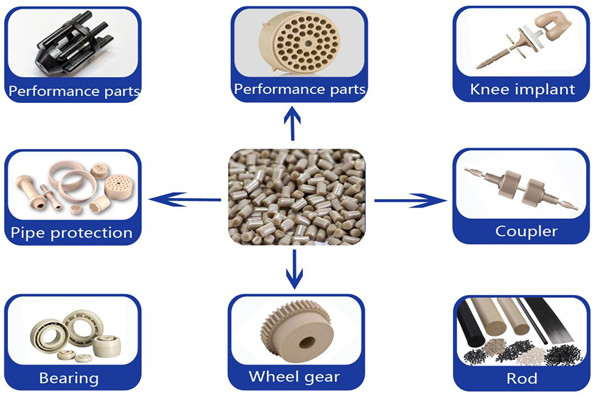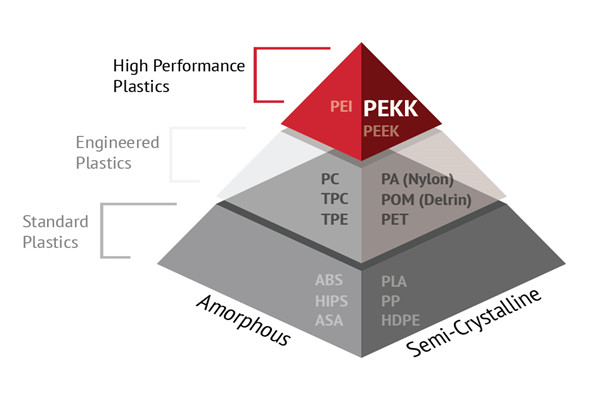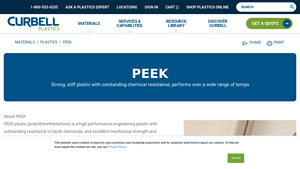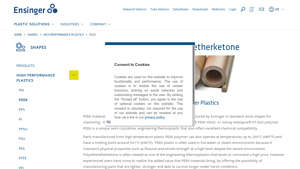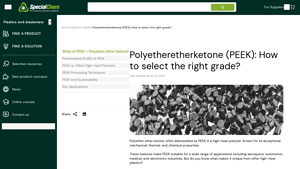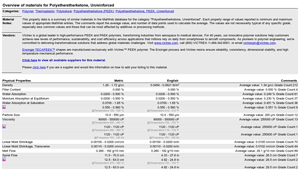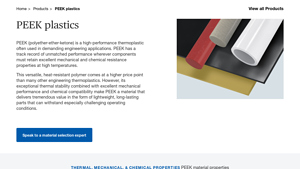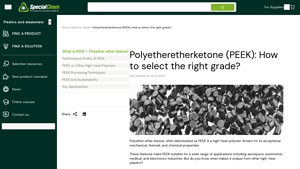Peek Plastic Properties Guide: Type, Cost, Top List…
Introduction: Navigating the Global Market for peek plastic properties
In the competitive landscape of global manufacturing, sourcing high-performance materials like PEEK (polyetheretherketone) can present significant challenges. Buyers often grapple with understanding the diverse properties of PEEK plastics, such as their exceptional chemical resistance, thermal stability, and mechanical strength, which are crucial for applications in industries ranging from aerospace to medical devices. This guide aims to demystify PEEK plastic properties, providing an in-depth analysis of its various grades, applications, and performance characteristics.
International B2B buyers from regions like Africa, South America, the Middle East, and Europe—particularly in countries like Germany and Nigeria—will find this guide invaluable in navigating the complexities of sourcing PEEK. We will explore the different types of PEEK, their specific applications, and practical insights into supplier vetting processes, allowing businesses to make informed purchasing decisions. Additionally, we will discuss cost considerations and the long-term value that high-quality PEEK materials can bring to your operations.
By equipping you with detailed knowledge about PEEK plastic properties and their implications for various industries, this guide empowers you to optimize your procurement strategies, ensuring that you select the right materials for your specific needs. Whether you are looking to enhance product performance or improve operational efficiencies, understanding PEEK is essential for driving success in today’s demanding market.
Understanding peek plastic properties Types and Variations
| Type Name | Key Distinguishing Features | Primary B2B Applications | Brief Pros & Cons for Buyers |
|---|---|---|---|
| Virgin PEEK | Naturally abrasion resistant, excellent dimensional stability | Aerospace, semiconductor machinery | Pros: High performance; Cons: Higher cost |
| Glass-Filled PEEK | Enhanced mechanical and thermal properties | Oil and gas, food processing machinery | Pros: Improved strength; Cons: Heavier |
| Bearing Grade PEEK | Superior wear resistance, ideal for moving parts | Bearings, bushings, seals | Pros: Extended lifespan; Cons: Limited flexibility |
| FDA Compliant PEEK | Meets FDA regulations for food and medical use | Food processing, medical instruments | Pros: Safe for sensitive applications; Cons: Premium pricing |
| Metal & X-ray Detectable PEEK | Detectable for safety in food and pharmaceutical industries | Food and beverage processing, pharmaceutical | Pros: Enhanced safety; Cons: Specialized applications |
What are the Characteristics of Virgin PEEK and Its Applications?
Virgin PEEK, or unfilled PEEK, is known for its outstanding abrasion resistance and dimensional stability. This type is particularly suitable for high-performance applications in industries such as aerospace and semiconductor manufacturing. When purchasing Virgin PEEK, buyers should consider its high cost relative to other plastics, but its performance in extreme environments often justifies the investment.
How Does Glass-Filled PEEK Enhance Performance?
Glass-Filled PEEK incorporates glass fibers to enhance its mechanical and thermal properties. This variation is ideal for applications in oil and gas industries, as well as food processing machinery, where mechanical strength and thermal stability are crucial. Buyers should weigh the benefits of increased strength against the potential for added weight and cost, especially in applications where weight savings are critical.
Why Choose Bearing Grade PEEK for Moving Parts?
Bearing Grade PEEK is specifically designed for applications requiring superior wear resistance and durability, making it an excellent choice for bearings, bushings, and seals. Its unique properties extend the lifespan of components in demanding environments. Buyers should consider the long-term cost savings from reduced maintenance and replacement when evaluating this option, despite its potentially higher initial price.
What Benefits Does FDA Compliant PEEK Offer?
FDA Compliant PEEK is formulated to meet stringent regulations for food and medical applications, making it a safe choice for sensitive industries. It is widely used in food processing and medical instruments. While the premium pricing may be a concern for some buyers, the assurance of compliance with safety standards can significantly mitigate risk and enhance marketability.
How Does Metal & X-ray Detectable PEEK Improve Safety?
Metal & X-ray Detectable PEEK is engineered for use in food and pharmaceutical industries where safety and compliance are paramount. This variation allows for easy detection in case of contamination, thus ensuring consumer safety. Buyers in these sectors should prioritize this type for its safety benefits, although it may come with specialized applications and higher costs.
Key Industrial Applications of peek plastic properties
| Industry/Sector | Specific Application of peek plastic properties | Value/Benefit for the Business | Key Sourcing Considerations for this Application |
|---|---|---|---|
| Aerospace | Components for aircraft engines and systems | High strength-to-weight ratio enhances fuel efficiency | Ensure compliance with aerospace standards; consider heat resistance and weight specifications. |
| Oil and Gas | Seals and valves in high-pressure systems | Durability in extreme conditions reduces downtime | Look for chemical resistance and high-temperature ratings; verify supplier certifications. |
| Medical Devices | Surgical instruments and implants | Biocompatibility ensures patient safety | Source FDA-compliant grades; assess machining capabilities for precision parts. |
| Food Processing | Machinery components that require sterilization | Long-lasting performance minimizes maintenance costs | Ensure compliance with food safety regulations; consider custom sizes for specific machinery. |
| Semiconductor Manufacturing | Parts for semiconductor fabrication equipment | Enhanced reliability leads to higher production yields | Verify material purity and electrical properties; consider the supplier’s experience in high-tech applications. |
How Is PEEK Plastic Used in Aerospace Applications?
In the aerospace industry, PEEK plastic is utilized for manufacturing lightweight components in aircraft engines and systems. Its exceptional mechanical strength and thermal stability are critical for ensuring performance under extreme conditions. By using PEEK, manufacturers can achieve significant weight savings, which directly translates to improved fuel efficiency and reduced operational costs. International buyers must ensure that sourced PEEK meets stringent aerospace standards and specifications related to heat resistance and weight.
What Role Does PEEK Play in Oil and Gas Applications?
PEEK plastic finds extensive use in the oil and gas sector, particularly for seals and valves that operate in high-pressure environments. The material’s ability to withstand harsh chemicals and extreme temperatures makes it ideal for maintaining operational integrity in challenging conditions. By employing PEEK components, companies can minimize equipment failures and costly downtime. Buyers should prioritize sourcing from suppliers that offer high-temperature ratings and can provide certifications for chemical resistance.
Why Is PEEK Important for Medical Devices?
In the medical field, PEEK is increasingly used for surgical instruments and implants due to its biocompatibility and mechanical properties. This high-performance plastic ensures patient safety while providing durability and resistance to sterilization processes. The ability to machine PEEK into precise shapes is crucial for the functionality of medical devices. Buyers in this sector should focus on acquiring FDA-compliant grades and assess the supplier’s capabilities in fabricating intricate components.
How Does PEEK Enhance Food Processing Equipment?
PEEK plastic is employed in food processing machinery components where sterilization is essential. Its resistance to chemicals and high temperatures allows it to maintain performance in demanding environments, ultimately leading to lower maintenance costs and increased equipment longevity. For international buyers, it is vital to ensure that the sourced PEEK complies with food safety regulations and to consider custom sizes that fit specific machinery requirements.
What Are the Benefits of PEEK in Semiconductor Manufacturing?
In semiconductor manufacturing, PEEK is used for components in fabrication equipment, where reliability and precision are paramount. The material’s excellent electrical insulation and thermal stability contribute to higher production yields and reduced equipment failure rates. Buyers in this high-tech sector should verify the purity of the PEEK material and its electrical properties, as well as the supplier’s experience in delivering solutions tailored to advanced manufacturing processes.
3 Common User Pain Points for ‘peek plastic properties’ & Their Solutions
Scenario 1: High Temperature Performance Issues in Harsh Environments
The Problem: B2B buyers in industries such as aerospace, oil and gas, or food processing often face challenges with materials that cannot withstand extreme temperatures. For instance, components used in high-temperature environments may begin to degrade, losing mechanical integrity and dimensional stability. This can lead to equipment failures, production downtimes, and increased maintenance costs, ultimately impacting the bottom line.
The Solution: To effectively utilize PEEK plastic properties, buyers should prioritize sourcing high-performance grades that are specifically designed for high-temperature applications. Selecting the right grade, such as glass-filled PEEK, can enhance thermal stability and mechanical strength. It’s advisable to consult with suppliers who can provide detailed specifications and test data on how different PEEK grades perform at elevated temperatures. Additionally, implementing a thorough testing protocol in actual operating conditions can help validate performance before full-scale deployment. Regularly reviewing supplier certifications for PEEK grades, particularly those that indicate compliance with industry standards, ensures that the selected materials will perform reliably under expected conditions.
Scenario 2: Chemical Resistance in Diverse Applications
The Problem: Industries such as pharmaceuticals and food processing require materials that can resist aggressive chemicals and cleaning agents. A common pain point arises when standard plastics fail to meet chemical resistance requirements, leading to contamination risks, product recalls, or even regulatory penalties. Buyers often struggle to identify the right material that can withstand prolonged exposure to these harsh substances without degrading.
The Solution: Buyers should consider PEEK for its outstanding chemical resistance, particularly in applications where exposure to steam, water, and various solvents is frequent. When specifying PEEK, it is crucial to review the chemical compatibility charts provided by manufacturers to ensure the selected grade will withstand specific chemicals used in their processes. Additionally, opting for FDA-compliant grades of PEEK can provide the necessary assurance for applications in food and beverage processing. Implementing a collaborative approach with suppliers, including trials and feedback loops, can help refine material selection and ensure compliance with industry standards while optimizing operational efficiency.
Scenario 3: Sourcing and Custom Fabrication Challenges
The Problem: Many B2B buyers experience difficulties in sourcing PEEK materials that meet specific dimensional and performance requirements. The wide range of applications for PEEK, from semiconductor manufacturing to aerospace components, often necessitates custom shapes and sizes. Buyers may find it challenging to locate suppliers who can provide tailored solutions without long lead times or excessive costs.
The Solution: To mitigate sourcing challenges, buyers should partner with manufacturers that offer a comprehensive portfolio of PEEK shapes and custom fabrication services. Engaging with suppliers who have extensive experience in PEEK extrusion can lead to more efficient manufacturing processes, reducing lead times for custom components. Buyers should also consider discussing their specific needs upfront, including desired dimensions, performance characteristics, and volume requirements, to facilitate a more streamlined production process. Utilizing CAD models and prototypes can aid in visualizing the final product, allowing for adjustments before full-scale production. Additionally, establishing long-term relationships with reliable suppliers can ensure consistent quality and availability of PEEK materials tailored to evolving project needs.
Strategic Material Selection Guide for peek plastic properties
What Are the Key Properties of PEEK Plastic Materials for B2B Applications?
PEEK (Polyetheretherketone) is a high-performance thermoplastic known for its exceptional mechanical and thermal properties, making it a preferred choice in various demanding applications. Below, we analyze several common grades of PEEK plastic, focusing on their properties, advantages, disadvantages, and implications for international B2B buyers.
What Are the Key Properties of Virgin PEEK?
Key Properties: Virgin PEEK exhibits excellent chemical resistance, high tensile strength (up to 14,000 psi), and a maximum continuous service temperature of 480°F (260°C). Its low water absorption (0.5%) ensures dimensional stability in humid environments.
Pros & Cons: The primary advantage of virgin PEEK is its unmatched mechanical strength and thermal stability, making it suitable for various applications, including aerospace and semiconductor industries. However, its high cost can be a barrier for some manufacturers, and it may not be the best choice for applications requiring additional wear resistance.
Impact on Application: Virgin PEEK is ideal for high-stress environments where chemical exposure is a concern. Its properties make it compatible with a wide range of media, including steam and aggressive chemicals.
Considerations for International Buyers: Buyers from regions like Africa and South America should ensure compliance with local regulations and standards, such as ASTM or DIN. The high cost may necessitate a thorough cost-benefit analysis to justify its use.
How Does Glass-Filled PEEK Enhance Performance?
Key Properties: Glass-filled PEEK offers improved mechanical and thermal properties compared to virgin PEEK, including higher tensile strength and enhanced dimensional stability. It can withstand temperatures up to 300°F (150°C) and has excellent resistance to harsh chemicals.
Pros & Cons: The addition of glass fibers increases strength and rigidity, making it suitable for applications requiring enhanced load-bearing capabilities. However, the increased manufacturing complexity and cost may deter some companies from opting for this grade.
Impact on Application: Glass-filled PEEK is particularly effective in applications like bearings and bushings, where wear resistance and mechanical performance are critical. Its compatibility with various chemicals makes it a versatile choice for industries ranging from oil and gas to food processing.
Considerations for International Buyers: Buyers should be aware of the specific grades available and their compliance with industry standards. The higher cost might be justified by the performance benefits in demanding applications.
What Are the Benefits of FDA Compliant PEEK?
Key Properties: FDA compliant PEEK is designed for applications in the food and pharmaceutical industries. It maintains the same high-performance characteristics as virgin PEEK while meeting stringent regulatory requirements for safety and hygiene.
Pros & Cons: The main advantage of FDA compliant PEEK is its ability to be used in direct contact with food and pharmaceuticals, ensuring safety and compliance. However, its cost is typically higher than standard grades, which may limit its use in less critical applications.
Impact on Application: This grade is essential for components in food processing machinery and medical devices, where regulatory compliance is non-negotiable. Its chemical resistance and thermal stability ensure long-lasting performance in these applications.
Considerations for International Buyers: Buyers in Europe and the Middle East should pay close attention to local regulations regarding food safety and medical device compliance. Understanding the specific requirements can help in selecting the right grade.
Summary Table of PEEK Plastic Properties
| Material | Typical Use Case for peek plastic properties | Key Advantage | Key Disadvantage/Limitation | Relative Cost (Low/Med/High) |
|---|---|---|---|---|
| Virgin PEEK | Aerospace components, semiconductor parts | Exceptional mechanical strength and thermal stability | High cost | High |
| Glass-Filled PEEK | Bearings, bushings, and seals | Enhanced load-bearing capabilities | Increased manufacturing complexity | High |
| FDA Compliant PEEK | Food processing machinery, medical devices | Meets stringent safety and hygiene regulations | Higher cost than standard grades | High |
This strategic material selection guide provides valuable insights for international B2B buyers, assisting in making informed decisions regarding PEEK plastic properties tailored to their specific applications and regional requirements.
In-depth Look: Manufacturing Processes and Quality Assurance for peek plastic properties
What Are the Main Stages in the Manufacturing Process of PEEK Plastic?
The manufacturing process of PEEK (polyetheretherketone) plastic involves several critical stages that ensure the production of high-quality components suitable for demanding applications. Each stage plays a vital role in determining the final properties of the material.
Material Preparation: How Is PEEK Plastic Raw Material Processed?
The first step in manufacturing PEEK involves the preparation of raw materials, typically in the form of granules or pellets. These materials are carefully selected based on their intended application. High-quality PEEK is often sourced from reputable suppliers like Victrex® or Solvay, known for their consistency and performance.
The granules undergo a drying process to remove moisture, which is crucial for maintaining the integrity of the final product. Excess moisture can lead to defects during the processing phase, such as bubbles or weak spots. This step is particularly important for applications in aerospace and medical sectors, where material performance is critical.
How Is PEEK Plastic Formed into Desired Shapes?
Once the raw material is prepared, it is subjected to forming processes. The most common techniques include extrusion, injection molding, and compression molding:
-
Extrusion: In this method, the dried PEEK granules are heated until they melt and are then forced through a die to create sheets, rods, or tubes. This technique is advantageous for producing continuous lengths of material.
-
Injection Molding: This technique involves injecting molten PEEK into a mold. It is ideal for creating complex shapes with tight tolerances, making it a preferred method for producing components like bearings and seals.
-
Compression Molding: In this process, PEEK is placed in a heated mold and compressed to form the desired shape. This method is suitable for thicker components and can accommodate larger geometries.
What Finishing Techniques Are Applied to PEEK Products?
After forming, PEEK components often require finishing to meet specific tolerances and surface quality. Common finishing techniques include:
-
Machining: Precision machining can be employed to refine dimensions and surface finish. This process is critical for applications that require high accuracy, such as semiconductor equipment.
-
Surface Treatment: Depending on the end-use, surface treatments like polishing or coating can enhance properties such as wear resistance or chemical stability.
-
Custom Fabrication: For specialized applications, suppliers may offer custom fabrication services to meet unique specifications, ensuring that components are tailored for their intended use.
What Quality Control Measures Are Essential for PEEK Plastic?
Quality control (QC) is a fundamental aspect of PEEK manufacturing, ensuring that the final products meet international standards and customer expectations. A robust QC process is particularly important for B2B buyers who require reliability and consistency in their supply chains.
Which International Standards Govern PEEK Quality Assurance?
PEEK manufacturers often adhere to international quality standards, such as ISO 9001, which outlines requirements for a quality management system. Compliance with ISO standards demonstrates a commitment to quality and continuous improvement. Additionally, industry-specific certifications may include:
- CE Marking: Indicates compliance with European health, safety, and environmental protection standards.
- API Certification: Relevant for manufacturers supplying the oil and gas sector, ensuring adherence to quality standards specific to that industry.
What Are the Key Checkpoints in the Quality Control Process?
Quality control for PEEK manufacturing typically involves several checkpoints:
-
Incoming Quality Control (IQC): This initial phase assesses the quality of raw materials before processing begins. Suppliers must provide material certificates to confirm compliance with specified standards.
-
In-Process Quality Control (IPQC): During the manufacturing process, various parameters such as temperature, pressure, and cycle times are monitored. Regular inspections help identify potential issues before they affect the final product.
-
Final Quality Control (FQC): After production, finished products undergo rigorous testing to verify their properties. Common testing methods include:
- Mechanical Testing: Evaluating properties like tensile strength and impact resistance.
- Thermal Testing: Assessing heat deflection and thermal stability under specified conditions.
- Chemical Resistance Testing: Ensuring the material can withstand exposure to relevant chemicals.
How Can B2B Buyers Verify Supplier Quality Control?
B2B buyers, particularly in diverse regions such as Africa, South America, the Middle East, and Europe, should conduct thorough due diligence when selecting suppliers for PEEK products. Here are key strategies to verify quality control:
-
Supplier Audits: Conducting on-site audits allows buyers to assess manufacturing processes, QC measures, and compliance with international standards firsthand.
-
Quality Reports: Requesting detailed quality reports, including test results and certifications, can provide insight into the supplier’s commitment to quality.
-
Third-Party Inspections: Engaging third-party inspection agencies can ensure impartial assessments of the manufacturing and quality control processes. These agencies can offer certifications that enhance credibility.
What Are the Quality Control and Certification Nuances for International B2B Buyers?
For international B2B buyers, understanding the nuances of quality control and certification is essential. Variations in regulations and standards across regions can affect product acceptance. Buyers should be aware of:
-
Regional Compliance Requirements: Different countries may have specific regulations regarding material properties, safety standards, and environmental impact. Familiarizing oneself with these requirements is crucial for successful market entry.
-
Documentation and Certification: Ensure that suppliers provide all necessary documentation, including compliance certificates, test reports, and material safety data sheets (MSDS). This documentation is vital for customs clearance and regulatory compliance.
-
Cultural Considerations: Cultural differences can influence business practices and communication. Establishing clear expectations and maintaining open lines of communication with suppliers can help mitigate misunderstandings.
In conclusion, understanding the manufacturing processes and quality assurance measures for PEEK plastic is crucial for B2B buyers aiming to source high-performance materials. By prioritizing quality control and verifying supplier capabilities, buyers can ensure they receive reliable products that meet their specific needs.
Practical Sourcing Guide: A Step-by-Step Checklist for ‘peek plastic properties’
This guide serves as a practical checklist for B2B buyers looking to procure PEEK plastic, focusing on its properties and applications. PEEK (Polyetheretherketone) is a high-performance thermoplastic known for its exceptional mechanical strength, chemical resistance, and thermal stability. Understanding its properties and how to source it effectively is crucial for making informed purchasing decisions.
Step 1: Define Your Technical Specifications
Before initiating the procurement process, clearly outline the technical requirements for PEEK plastic. This includes understanding the intended application, temperature ranges, and environmental conditions the material will face. Specific attributes such as tensile strength, chemical resistance, and FDA compliance are essential to ensure the material meets your operational needs.
Step 2: Research Available Grades of PEEK
PEEK comes in various grades tailored for different applications, including virgin PEEK, glass-filled PEEK, and bearing-grade PEEK. Investigate which grade aligns with your project requirements, considering factors like mechanical properties and chemical compatibility. Each grade offers unique benefits; for example, glass-filled PEEK enhances thermal and mechanical properties, while FDA-compliant grades are suitable for food and pharmaceutical applications.
Step 3: Evaluate Potential Suppliers
Conduct thorough research on suppliers specializing in PEEK plastic. Request detailed company profiles, product catalogs, and case studies to assess their expertise and reliability. Look for suppliers with a proven track record in your industry to ensure they can meet your specific needs. Consider factors like their manufacturing capabilities and adherence to quality standards.
Step 4: Verify Certifications and Compliance
Ensure that the suppliers you are considering hold relevant certifications, such as ISO 9001 or ASTM compliance. This guarantees that the materials meet industry standards and regulatory requirements, particularly for sensitive applications in sectors like aerospace and medical. Additionally, verify any specific certifications related to your industry, such as FDA compliance for food processing applications.
Step 5: Request Samples for Testing
Before making a bulk purchase, request samples of the PEEK material from shortlisted suppliers. Conduct tests to evaluate the material’s performance under conditions similar to those it will face in actual use. This step is critical to ascertain that the material meets your technical specifications and to identify any potential issues before finalizing your order.
Step 6: Analyze Pricing and Total Cost of Ownership
While price is an important factor, consider the total cost of ownership, which includes material longevity, performance, and potential downtime. PEEK may be more expensive than standard plastics, but its durability and performance can lead to cost savings over time. Evaluate quotes from different suppliers, ensuring that you are comparing similar grades and specifications.
Step 7: Establish Clear Terms and Conditions
Once you select a supplier, clarify all terms and conditions related to the purchase, including lead times, payment terms, and return policies. A well-defined agreement helps mitigate risks and ensures that both parties are aligned on expectations. Discuss any warranties or guarantees related to the performance of the PEEK material to safeguard your investment.
By following this checklist, B2B buyers can make informed decisions when sourcing PEEK plastic, ensuring they select the right material and supplier for their specific needs.
Comprehensive Cost and Pricing Analysis for peek plastic properties Sourcing
Understanding the cost structure and pricing dynamics of sourcing PEEK plastic is crucial for international B2B buyers, especially those operating in diverse markets such as Africa, South America, the Middle East, and Europe. This section provides a comprehensive analysis of the various cost components, influencing factors, and practical tips for buyers looking to optimize their procurement processes.
What Are the Key Cost Components in Sourcing PEEK Plastic?
The cost structure for PEEK plastic can be broken down into several key components:
-
Materials: The cost of raw PEEK polymer is a significant factor. Prices can fluctuate based on market demand, availability, and the quality of the polymer used. High-performance grades, such as glass-filled or FDA-compliant PEEK, tend to command higher prices due to their enhanced properties.
-
Labor: Labor costs involve the workforce required for manufacturing and processing PEEK materials. Skilled labor is often necessary for machining and fabricating components, which can impact overall pricing.
-
Manufacturing Overhead: This includes costs associated with maintaining production facilities, equipment depreciation, energy consumption, and indirect labor. Given the specialized nature of PEEK production, overhead can be relatively high.
-
Tooling: The creation of molds and tools for custom components can represent a significant upfront investment. This cost is often amortized over the production run, making volume purchasing more economical.
-
Quality Control (QC): Ensuring the final product meets stringent quality standards incurs additional costs. This includes testing for mechanical properties, chemical resistance, and compliance with industry certifications.
-
Logistics: Shipping, handling, and warehousing expenses can vary significantly based on the destination and Incoterms used. International logistics may also include tariffs and customs duties that further impact costs.
-
Margin: Suppliers typically build in a profit margin, which can vary based on their operational costs and market positioning.
How Do Price Influencers Affect PEEK Plastic Sourcing?
Several factors can influence the pricing of PEEK plastic, including:
-
Volume/MOQ: Larger orders often lead to reduced per-unit costs. Suppliers may offer tiered pricing based on minimum order quantities (MOQs), making it essential for buyers to assess their needs accurately.
-
Specifications and Customization: Custom grades or specific dimensions can increase costs. Buyers should clearly communicate their requirements to avoid unexpected expenses.
-
Material Quality and Certifications: Higher-quality materials or those with specific certifications (e.g., FDA compliance) typically come at a premium. Understanding the intended application can help buyers justify these costs.
-
Supplier Factors: The supplier’s reputation, production capacity, and geographical location can also affect pricing. Established suppliers with a track record of reliability may charge more, but they often provide better quality assurance.
-
Incoterms: The choice of Incoterms can significantly impact total costs. Buyers should evaluate options like FOB (Free On Board) or CIF (Cost, Insurance, and Freight) to determine the most cost-effective shipping arrangements.
What Are the Best Practices for Negotiating PEEK Plastic Prices?
To optimize costs when sourcing PEEK plastic, consider the following buyer tips:
-
Negotiate Terms: Engage in discussions with suppliers to negotiate pricing, payment terms, and delivery schedules. Establishing a long-term relationship can lead to better pricing over time.
-
Focus on Total Cost of Ownership (TCO): Evaluate not just the purchase price but the total cost, including maintenance, durability, and performance in application. This holistic view can reveal the true value of PEEK plastic.
-
Understand Pricing Nuances: International buyers should be aware of currency fluctuations, import tariffs, and local market conditions that may affect pricing. Conducting thorough market research can help in making informed purchasing decisions.
-
Leverage Volume Discounts: If possible, consolidate orders to reach higher volume thresholds, which can unlock significant savings.
In conclusion, understanding the cost structure and pricing influencers associated with PEEK plastic is essential for B2B buyers. By focusing on negotiation, total cost of ownership, and market dynamics, buyers can make informed decisions that enhance their procurement strategies. Always approach sourcing with a comprehensive view to maximize value and minimize costs.
Alternatives Analysis: Comparing peek plastic properties With Other Solutions
Exploring Alternatives to PEEK Plastic Properties for B2B Applications
In the competitive landscape of engineering materials, businesses often seek alternatives to high-performance plastics like PEEK (polyetheretherketone) that meet specific project requirements. By understanding the properties, advantages, and limitations of PEEK compared to other materials, international B2B buyers can make informed decisions that align with their operational goals and budget constraints.
| Comparison Aspect | Peek Plastic Properties | Alternative 1: Ultem® (Polyetherimide) | Alternative 2: Torlon® (Polyamide-imide) |
|---|---|---|---|
| Performance | Excellent chemical resistance, high heat stability (up to 260°C continuous) | Good chemical resistance, high thermal stability (up to 200°C) | Superior thermal stability (up to 260°C), good chemical resistance |
| Cost | High cost (premium material) | Moderate cost | High cost (similar to PEEK) |
| Ease of Implementation | Easy to machine and fabricate | Moderate machining difficulty | Complex machining due to toughness |
| Maintenance | Low maintenance, durable in harsh environments | Low maintenance, good long-term stability | Low maintenance, but susceptible to water absorption |
| Best Use Case | Aerospace, semiconductor, medical applications | Electronics, aerospace, and automotive | Aerospace, automotive, and oil & gas industries |
Detailed Breakdown of Alternatives
Ultem® (Polyetherimide)
Ultem® is known for its excellent electrical properties and heat resistance, making it suitable for applications in the electronics and aerospace sectors. It can withstand temperatures up to 200°C, which is lower than PEEK but still significant for many applications. The cost of Ultem® is moderate compared to PEEK, making it a viable option for companies looking to balance performance and budget. However, its machining can be more challenging than PEEK, which may require specialized equipment.
Torlon® (Polyamide-imide)
Torlon® offers exceptional thermal stability and is ideal for applications requiring high strength and durability under extreme temperatures (up to 260°C). Its excellent chemical resistance makes it suitable for harsh environments, particularly in aerospace and oil & gas applications. However, Torlon® is also priced similarly to PEEK, which could be a consideration for budget-sensitive projects. Its toughness can complicate machining processes, potentially leading to increased labor costs.
Conclusion: Choosing the Right Solution for Your Needs
When evaluating alternatives to PEEK plastic properties, B2B buyers should consider the specific requirements of their applications, including temperature resistance, chemical exposure, mechanical strength, and budget limitations. While PEEK remains a top choice for high-performance needs, materials like Ultem® and Torlon® can provide comparable benefits at different price points and application suitability. By carefully analyzing the performance characteristics and operational demands, businesses can select the most appropriate material that aligns with their project objectives and financial considerations.
Essential Technical Properties and Trade Terminology for peek plastic properties
What are the Key Technical Properties of PEEK Plastic?
When considering PEEK (polyetheretherketone) for industrial applications, understanding its critical specifications is essential for making informed purchasing decisions. Here are some key properties to consider:
1. Material Grades
PEEK is available in various grades, each tailored for specific applications. For instance, virgin PEEK is known for its natural abrasion resistance, while glass-filled PEEK enhances mechanical and thermal properties. This distinction is crucial for B2B buyers as selecting the right grade can lead to improved performance in demanding environments, such as aerospace or medical applications.
2. Tolerance Levels
Tolerance refers to the permissible limit of variation in a physical dimension. For PEEK products, this can include length, width, and thickness. Understanding tolerance levels is critical for manufacturers to ensure that components fit seamlessly within assemblies, reducing the risk of failure and downtime. Suppliers often provide custom tolerances, which can be advantageous for specialized projects.
3. Heat Deflection Temperature (HDT)
HDT indicates the temperature at which a material deforms under a specified load. For PEEK, this value can reach up to 306°F (150°C) at 66 psi, making it suitable for applications involving high temperatures, such as in oil and gas or semiconductor machinery. B2B buyers must consider HDT when evaluating materials for environments that experience thermal stress.
4. Chemical Resistance
PEEK is renowned for its exceptional chemical resistance, making it ideal for use in harsh environments where exposure to corrosive substances is common. This property is particularly important for industries like food processing and pharmaceuticals, where compliance with safety standards is paramount. Understanding the chemical compatibility of PEEK can help businesses avoid costly material failures.
5. Mechanical Properties
Key mechanical properties of PEEK include tensile strength and flexural modulus. For example, PEEK can achieve a tensile strength of up to 14,000 psi, providing durability and resistance to wear. Buyers should assess these properties based on their application needs to ensure optimal performance and longevity of components.
What are Common Trade Terms in PEEK Plastic Procurement?
Navigating the procurement process for PEEK plastic involves understanding industry-specific jargon. Here are several common terms:
1. OEM (Original Equipment Manufacturer)
An OEM is a company that produces parts or equipment that may be marketed by another manufacturer. In the context of PEEK, OEMs often require customized components that meet specific performance criteria, making it vital for suppliers to offer tailored solutions.
2. MOQ (Minimum Order Quantity)
MOQ refers to the smallest quantity of a product that a supplier is willing to sell. Understanding MOQs is essential for B2B buyers as they can impact inventory costs and production schedules. Buyers should negotiate MOQs that align with their operational needs.
3. RFQ (Request for Quotation)
An RFQ is a formal document that a buyer sends to suppliers to request pricing for specific products or services. This process is crucial for obtaining competitive bids for PEEK materials, allowing buyers to compare options effectively.
4. Incoterms (International Commercial Terms)
Incoterms are a set of rules that define the responsibilities of buyers and sellers in international trade. Familiarity with these terms helps B2B buyers understand shipping responsibilities, costs, and risks associated with PEEK procurement, facilitating smoother transactions.
5. Custom Fabrication
This term refers to the process of producing components to meet specific design specifications. Custom fabrication is particularly important for PEEK applications where standard sizes may not suffice. Buyers should inquire about fabrication capabilities to ensure that their unique requirements are met.
By understanding these technical properties and trade terms, B2B buyers can make more informed decisions regarding PEEK plastic procurement, ultimately leading to better performance and reliability in their applications.
Navigating Market Dynamics and Sourcing Trends in the peek plastic properties Sector
What Are the Current Trends in the Global PEEK Plastic Market?
The global market for PEEK (polyetheretherketone) plastic is witnessing significant growth, driven by several key factors. The increasing demand for high-performance materials in sectors such as aerospace, semiconductor, oil and gas, and medical devices is propelling PEEK’s adoption. These industries require materials that can withstand extreme temperatures and harsh chemical environments, making PEEK a preferred choice due to its exceptional mechanical strength and thermal stability.
Emerging technologies, such as advanced manufacturing techniques and additive manufacturing (3D printing), are reshaping sourcing strategies. B2B buyers are now able to procure customized PEEK components that meet specific application needs, reducing waste and lead times. The rise of Industry 4.0 is also influencing supply chains, with enhanced data analytics allowing buyers to make informed decisions based on real-time market dynamics.
International buyers, particularly from Africa, South America, the Middle East, and Europe, must navigate these evolving market conditions. In regions like Nigeria and Germany, the demand for advanced materials is increasing, but buyers must also consider logistics, import regulations, and local sourcing capabilities to optimize their supply chain efficiency.
How Does Sustainability Influence PEEK Plastic Sourcing Decisions?
Sustainability is becoming a critical factor in the sourcing of PEEK plastics. With growing awareness of environmental issues, businesses are increasingly prioritizing ethical sourcing practices. The production of high-performance plastics like PEEK can have significant environmental impacts, from resource extraction to manufacturing processes. Therefore, international B2B buyers are encouraged to seek suppliers who adhere to sustainable practices, including waste reduction and energy-efficient production methods.
Moreover, certifications such as ISO 14001 for environmental management systems can serve as indicators of a supplier’s commitment to sustainability. Buyers can also explore ‘green’ alternatives within the PEEK sector, such as bio-based PEEK materials, which aim to reduce the carbon footprint associated with traditional production methods. By prioritizing suppliers with robust sustainability credentials, B2B buyers can enhance their corporate responsibility profiles while ensuring the long-term viability of their supply chains.
What Is the Historical Context of PEEK Plastic Development?
PEEK was first introduced in the late 1980s as a high-performance engineering plastic, rapidly gaining traction due to its unique properties. Initially utilized in niche applications, PEEK’s versatility soon saw it adopted in critical industries such as aerospace and medical devices. Over the years, advancements in processing technologies have broadened its applications, allowing for the production of complex geometries and custom components.
The development of various grades of PEEK, including FDA-compliant options and those designed for specific mechanical properties, has further solidified its position in the market. As a result, PEEK has evolved from a specialized material to a mainstream choice for demanding applications, reflecting the growing need for materials that can perform under extreme conditions while meeting rigorous industry standards.
This evolution underscores the importance of understanding both the historical context and current trends in the PEEK market, enabling B2B buyers to make informed sourcing decisions that align with their operational requirements and strategic goals.
Frequently Asked Questions (FAQs) for B2B Buyers of peek plastic properties
-
How do I choose the right grade of PEEK plastic for my application?
Choosing the right grade of PEEK plastic depends on your specific application requirements. Consider factors such as temperature resistance, mechanical strength, and chemical compatibility. For high-temperature applications, look for grades that can withstand continuous use at elevated temperatures (up to 260°C). If your application involves food processing or pharmaceuticals, opt for FDA-compliant grades. Consulting with suppliers who specialize in PEEK can also provide insights into which grade best suits your needs based on application-specific performance characteristics. -
What industries commonly use PEEK plastic, and why?
PEEK plastic is widely used across various industries, including aerospace, automotive, semiconductor, medical, and food processing. Its exceptional mechanical strength, chemical resistance, and ability to perform in extreme temperatures make it an ideal choice for high-performance applications. In aerospace, for instance, PEEK is valued for its lightweight properties and durability under stress. The semiconductor industry benefits from PEEK’s electrical insulation properties, while the medical field utilizes its biocompatibility in surgical instruments. -
What are the typical lead times for sourcing PEEK plastic internationally?
Lead times for sourcing PEEK plastic can vary significantly based on the supplier, order size, and location. Typically, expect a lead time ranging from 2 to 8 weeks. Custom orders may take longer, especially if specific grades or sizes are required. It’s essential to communicate clearly with suppliers about your deadlines to ensure timely delivery. Additionally, consider potential delays related to international shipping and customs clearance, which can affect overall lead times. -
What customization options are available for PEEK plastic products?
Many suppliers offer customization options for PEEK plastic products, including specific dimensions, colors, and machining services. You can request tailored solutions based on your application requirements, such as custom shapes or finishes. Some manufacturers provide additional services like cutting, grinding, or fabrication to help you achieve your desired specifications. Always discuss your needs with the supplier to explore the available options and ensure the final product meets your exact requirements. -
What minimum order quantities (MOQs) should I expect when sourcing PEEK?
Minimum order quantities (MOQs) for PEEK plastic can vary by supplier and product type. Standard grades may have lower MOQs, often starting at 10 kg or more, while specialized grades or custom products might require larger orders, sometimes exceeding 50 kg. It’s advisable to inquire with multiple suppliers to compare their MOQs and negotiate terms that align with your purchasing strategy. Some suppliers may also offer flexibility for smaller orders, especially for new customers or trial runs. -
How do I ensure the quality of PEEK products before purchasing?
To ensure quality, request detailed material specifications and certifications from suppliers, including compliance with relevant industry standards. Look for suppliers that conduct rigorous quality control tests and can provide test data, such as tensile strength and thermal stability. Additionally, consider requesting samples to evaluate the material’s properties firsthand. Establishing a long-term relationship with reputable suppliers who have a proven track record can also help ensure consistent quality in your PEEK products. -
What payment terms are commonly offered for international B2B transactions involving PEEK?
Payment terms for international transactions can vary based on the supplier’s policies and the buyer’s creditworthiness. Common arrangements include advance payment, letters of credit, or net payment terms (e.g., net 30 or net 60 days). It’s essential to discuss and negotiate payment options upfront, considering factors such as order size and shipping terms. Establishing clear payment conditions can help mitigate risks and foster a smooth transaction process. -
What are the logistics considerations when importing PEEK plastic?
When importing PEEK plastic, consider logistics factors such as shipping methods, customs regulations, and import duties. Choose a reliable freight forwarder familiar with international shipping procedures to ensure compliance with local laws. Additionally, factor in lead times for shipping and customs clearance, which can affect project timelines. It’s also wise to explore different shipping options (air, sea, or land) to balance cost and speed based on your urgency and budget constraints.
Important Disclaimer & Terms of Use
⚠️ Important Disclaimer
The information provided in this guide, including content regarding manufacturers, technical specifications, and market analysis, is for informational and educational purposes only. It does not constitute professional procurement advice, financial advice, or legal advice.
While we have made every effort to ensure the accuracy and timeliness of the information, we are not responsible for any errors, omissions, or outdated information. Market conditions, company details, and technical standards are subject to change.
B2B buyers must conduct their own independent and thorough due diligence before making any purchasing decisions. This includes contacting suppliers directly, verifying certifications, requesting samples, and seeking professional consultation. The risk of relying on any information in this guide is borne solely by the reader.
Top 6 Peek Plastic Properties Manufacturers & Suppliers List
1. Curbell Plastics – PEEK High-Performance Engineering Plastic
Domain: curbellplastics.com
Registered: 2000 (25 years)
Introduction: PEEK (polyetheretherketone) is a high-performance engineering plastic known for its outstanding chemical resistance, mechanical strength, and dimensional stability. It is suitable for continuous use at temperatures up to 338°F (170°C) and is resistant to steam, water, and seawater. Common applications include semiconductor machinery components, aerospace parts, bushings, bearings, seals, pump and …
2. Ensinger – TECAPEEK PEEK Plastic
Domain: ensingerplastics.com
Registered: 2015 (10 years)
Introduction: PEEK plastic – TECAPEEK is a high-performance thermoplastic known for its excellent chemical compatibility and mechanical properties. It is available in standard stock shapes for machining, including sheets, rods, and tubes, and can be made from Victrex® PEEK 450G or Solvay Ketaspire® KT-820 polymer. PEEK can operate at temperatures up to 260°C (480°F) with a melting point of around 341°C (646°F)….
3. Omnexus – PEEK Polymer Solutions
Domain: omnexus.specialchem.com
Registered: 2000 (25 years)
Introduction: Polyether ether ketone (PEEK) is a high-heat polymer known for its exceptional mechanical, thermal, and chemical properties. It is suitable for applications in aerospace, automotive, medical, and electronics industries. PEEK is a semi-crystalline, high-performance engineering thermoplastic with a CAS Number of 29658-26-2 and a chemical formula of C19H14O3. It is fully recyclable and exhibits high …
4. MatWeb – Material Property Database
Domain: matweb.com
Registered: 1997 (28 years)
Introduction: This company, MatWeb – Material Property Database, is a notable entity in the market. For specific product details, it is recommended to visit their website directly.
5. MCAM – PEEK (Polyetheretherketone)
Domain: mcam.com
Registered: 1997 (28 years)
Introduction: {‘name’: ‘PEEK (Polyetheretherketone)’, ‘type’: ‘High-performance thermoplastic’, ‘properties’: {‘thermal_properties’: {‘heat_deflection_temperature’: ‘160°C or 320°F’, ‘maximum_service_temperature’: ‘250°C or 482°F’, ‘glass_transition_temperature’: ‘145°C or 290°F’, ‘melting_point’: ‘340°C or 644°F’, ‘thermal_conductivity’: {‘ISO’: ‘0.25 W/(K.m)’, ‘ASTM’: ‘1.75 BTU in./(hr.ft².°F)’}, ‘coefficient…
6. SpecialChem – PEEK High-Performance Polymer
Domain: specialchem.com
Registered: 2000 (25 years)
Introduction: Polyether ether ketone (PEEK) is a high-heat polymer known for its exceptional mechanical, thermal, and chemical properties. It is suitable for applications in aerospace, automotive, medical, and electronics industries. PEEK is a semi-crystalline, high-performance engineering thermoplastic with a CAS Number of 29658-26-2 and a chemical formula of C19H14O3. It has a high melting point of 343°C, a g…
Strategic Sourcing Conclusion and Outlook for peek plastic properties
In the competitive landscape of high-performance materials, PEEK plastic stands out due to its exceptional mechanical strength, thermal stability, and chemical resistance. For international B2B buyers, particularly those in Africa, South America, the Middle East, and Europe, understanding the unique properties of PEEK is essential for optimizing sourcing strategies. Leveraging PEEK’s capabilities allows companies to enhance product performance in demanding applications such as aerospace, semiconductor manufacturing, and food processing.
Strategic sourcing of PEEK not only ensures access to high-quality materials but also fosters long-term partnerships with reliable suppliers. This is vital in mitigating risks associated with supply chain disruptions and fluctuating market conditions. By prioritizing quality and performance, buyers can significantly reduce operational downtime and enhance the durability of their products.
Looking ahead, the demand for PEEK is expected to grow as industries increasingly seek materials that can withstand extreme conditions while maintaining performance. International buyers are encouraged to explore diverse sourcing options and consider suppliers who offer customization capabilities. Investing in PEEK now positions companies to stay ahead of the curve in innovation and efficiency. Make informed decisions today to drive your business success tomorrow.
